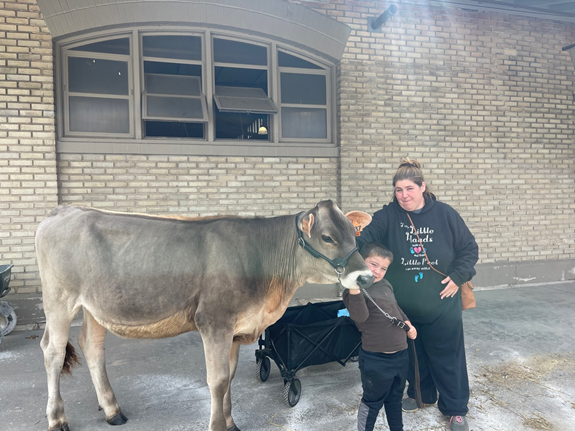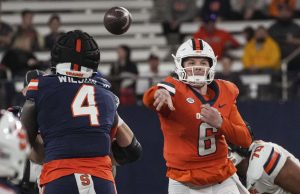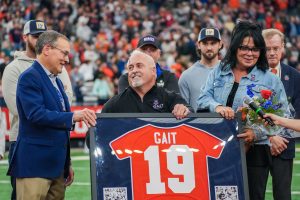Scenes from the Great New York State Fair
Scenes from the NY State Fair

Translating a juggling act into sign language. Falling 25 feet into an inflatable mattress. Explaining why the most famous place in Syracuse for chicken tenders has no chicken tenders. Continuing a tradition a century in the making.
Those are just a few of the thousands of moments created every day at the nation’s oldest state fair, first held in Syracuse in 1841.
2020 marked the first year since World War II that New York did not hold its annual fair. The fair returned this year with an 18-day run, its longest in history.
The NewsHouse had its photographers and reporters on the scene to capture the region’s largest and most colorful of events. Here’s a bit of what they saw.
Incessant squawking. Perpetual clucking. Interminable quacking.
Hundreds of birds, mostly chickens and ducks, line the first floor of the Poultry Building at the New York State Fairgrounds. The sight captivates. The smell overwhelms. And the sound, the sound, engulfs.
In past years, there were thousands more animals, including rabbits, guinea pigs, and pigeons. Bantam chickens alone used to cover over half of the second floor mezzanine — a corridor of cages, four wide and three high.
Despite the diminished flock, the atmosphere continues to overload the senses of visitors.
But John Pierce, the superintendent of the Poultry Building, thrives in this environment .
He doesn’t notice the sounds anymore. Not after a lifetime in the business.
Pierce yearns for the days of yesteryear, the heyday of poultry fairs.
Back when people arrived donned in their finest tuxedos, puffing a cigar.
Back when he didn’t have to worry about a cell phone ringing, interrupting his work.
Back when the Poultry Building thrived in the early 20th century, serving as one of the nation’s three main hosts. The other two: Madison Square Garden and Boston Garden.
Pierce started working at the Poultry Building in 1958. He recalls the morning cackling of the birds and the clamoring of nearby trains awaking him from his upstairs dorm room at 6 a.m. sharp, over four hours before opening.
But now, with well over 50 years of experience, the relentless chirping is ingrained in his daily life.
He finds no solace in silence. Only with the birds.
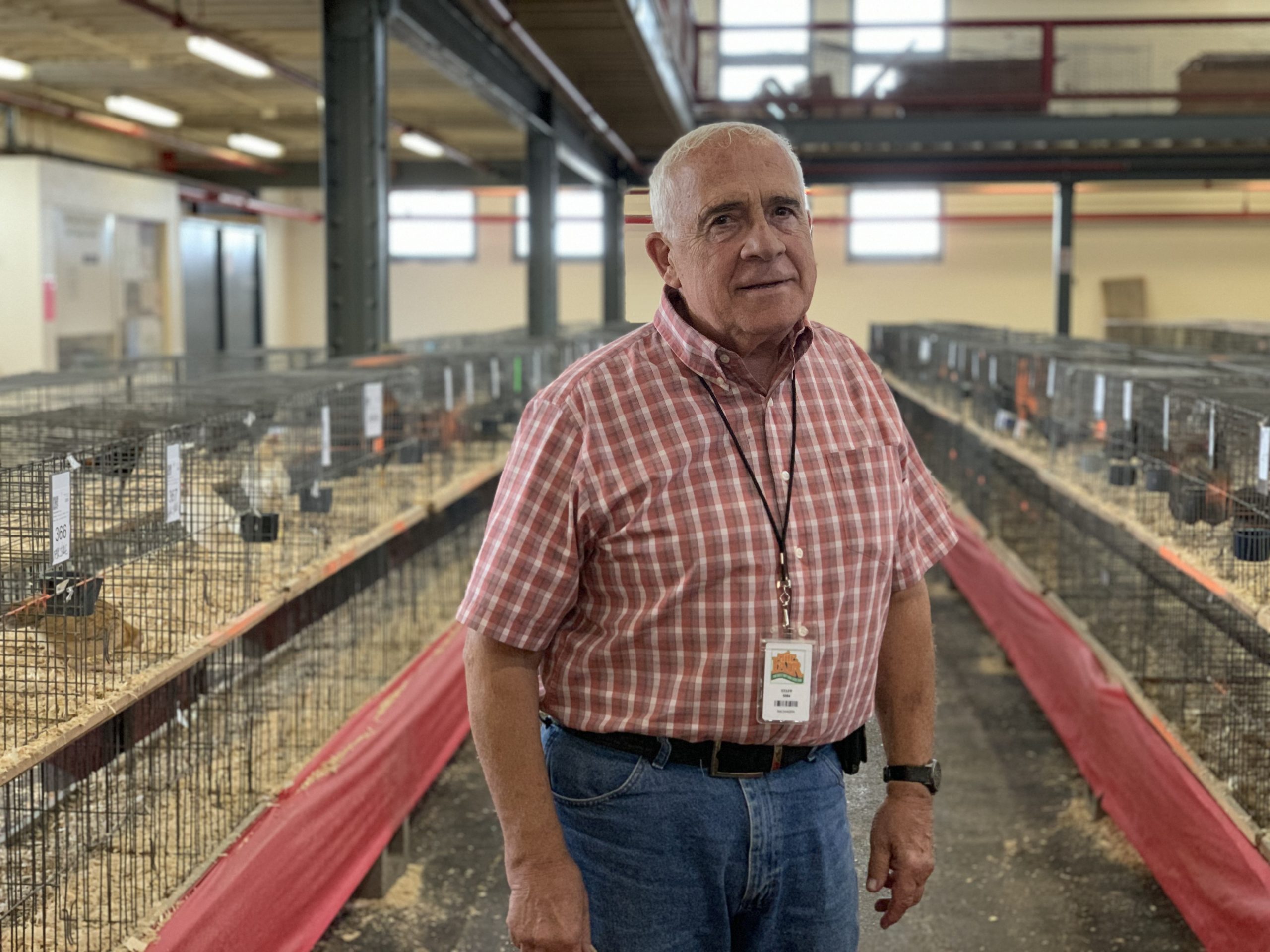
When May Harrington became an ASL interpreter, she didn’t anticipate signing words like “knife,” “trick” and “you killed my father,” all in the same context.
But those were the words and jokes Michael Hilby, the Skinny German Juggle Boy, used in his comedy juggling act at the New York State Fair on Tuesday evening.
Harrington, 28, used her hands and mouth to translate the act with an energy that matched Hilby’s, adding to the crowd’s amusement.
As a Syracuse native, she said she admires how the city has made events accessible for everyone –– especially those who are part of the deaf community.
“I think the best part is having a deaf person from the community come up and saying that they were able to enjoy the show and have fun at the show because it was accessible,” Harrington said.
She said Hilby’s interactions with the audience and his random techniques push her as an ASL interpreter. She never knows what he will do or say next, but that’s what makes it fun.
Luckily, Harrington has experience with the performer. She interpreted his show two years ago at the fair. “Working with Hilby is definitely one of my favorite parts of the fair,” she said.
A crowd circled around Hilby as he rocked on a balance board on top of a trunk.
Harringer used her middle and index fingers to sign a cutting motion for “knife.”
A young boy stood in front of the juggler, holding a three-sided, sharp-edged sword. Hilby instructed the boy, and Harringer signed the words, “Pointy side up. Pointy side up. You go, one, two, three, you let go.”
The boy let the sword go. Hilby caught it and juggled it along with a plunger and bowling pin. Everyone clapped.

The family of four with the boy on his fathers’ shoulders was lost. But John De Carlo was there to help them navigate the nearly 380,000 square foot New York State fairgrounds.
“Bingo! Right there,” De Carlo said, pointing across rows of flashing carnival games. “Go in there this way, veer to the right, and ask for Marilyn.”
2021 marked 30 years for De Carlo working at the fair – it’s no wonder he knows others on a first-name basis. He said he spent more than 25 of those years working the front gate before switching to the information booth inside the park.
“I will always love the main gate,” De Carlo said. “I was just ready for the next thing.”
Here, he waits in a small shack under the Ferris wheel lights for those who need his help. In the past, De Carlo said he gave people bags of free gifts from the fair. Now, the park’s “freebies” include hand sanitizer and masks.
“Most of them are very happy,” De Carlo said. “Things are more spread out, but people miss vendors that have always been here like Dinosaur Bar-B-Que and the SU store,” referring to two fair institutions that decided not to set up shop this year because of COVID.
As screams of rollercoaster passengers and the smell of funnel cake hang in the air, De Carlo remembers what makes the annual summer expo so memorable.
“A lot of people want the old days back,” De Carlo said, smiling. “But once they’re here, they’re having fun.”

Early Tuesday afternoon, the cows outnumbered the people at the New York State Fair’s dairy cattle exhibit.
Dairy farmer Scott Holcomb capitalized on the lull, picking up a rake and tending to the bed of hay his herd of seven both rested on and ate.
Raising dairy cattle has been an almost century long endeavor for the Holcombs, and during that century the clan has attended the state fair around 95 times.
“We are the second longest family (to come) here consecutively,” the 30-year-old farmer said.
His parents put him to work as soon as he could walk, and he recalled being surrounded by the half-ton creatures since he was 4.

The Holcomb farm, located in Greene, New York, is small and run by a team of four—Holcomb, his parents, and his wife, Emily (and sometimes baby Colton, too).
“There’s no extra help, there’s nothing to fall back on,” Holcomb said. “When my wife and I are here, it’s two less people taken away from home.”
Last year, the pandemic shut down the fair for the first time since World War II.
The fair’s closure didn’t affect Holcomb monetarily; it’s more of an extracurricular, he said. But the pandemic dealt a heavy blow to the already struggling dairy industry.
“The buyers were saying ‘No, we don’t have any room,’ and forcing us to basically dump milk,” Holcomb said.
Returning to the fair, Holcomb said, allows him to continue the family tradition and make life feel somewhat normal again.
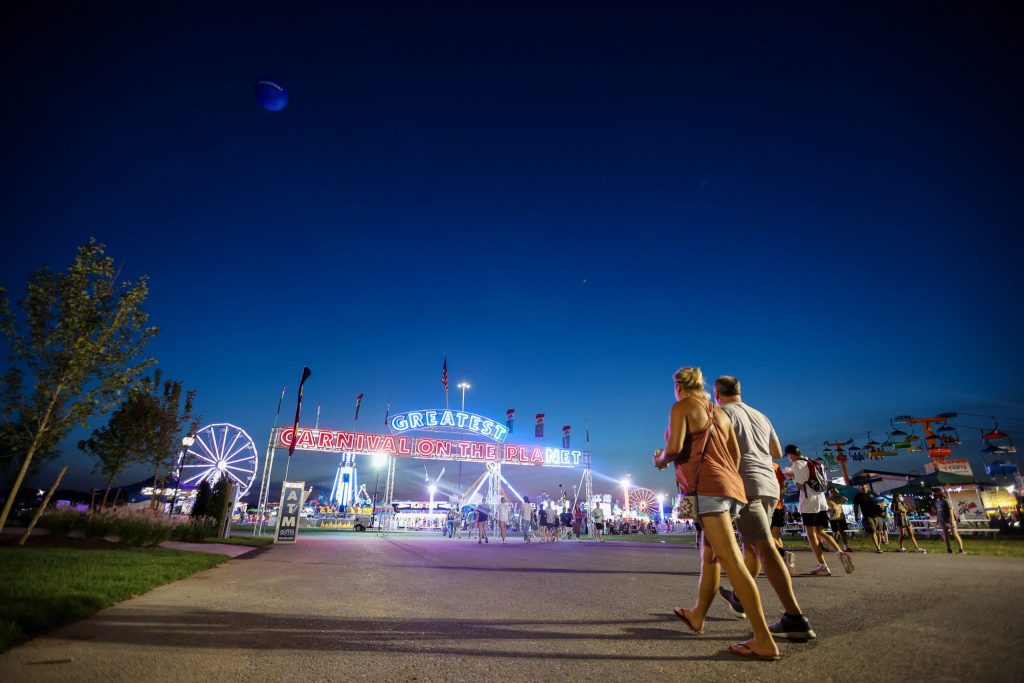
A pair of fairgoers walk toward the Midway.

An upside down view of the "Free Ride" rollercoaster.
Walking past the fried dough stand and the ring-toss booth, Jarrett Greene stopped to observe a station of caricature artists. He was at a theme park near his home in Charlotte, North Carolina. Clutching his own sketchbook under his arm, Greene looked at the artist’s canvas and at his subject and then back at the artist’s work.
“Oh man, I could do this!” he exclaimed.
An artist working the booth overheard him, and Greene showed her his sketchbook. The artist gave him the number of her boss.
That was 21 years ago, and Greene has drawn caricatures at fairs, weddings and theme parks up and down the east coast ever since. On busy days he can produce anywhere from 70 to 100 caricatures, with most works usually featuring pairs of people.
Green says his favorite part of the job is working with people and seeing their reactions. He particularly likes return customers.
“I was at the Erie County Fair a couple weeks ago,” said Greene at the New York State Fair on Tuesday . “A lady came up and she had me color a picture that I drew about three years ago. She said, ‘We were hoping you were here! We’ve been looking for you guys!’”
Greene will never stop drawing people, but he’s ready to give it up as a career. At 39 years old, Greene is returning to school to get a doctorate in Sport Science. “It’s its own form of creativity,” he said of his new career.

Bartender Adam Gillis poured a cup of Blue Light for the only customer at the bar. Country music blared, rattling the unused tables and empty chairs.
The evening drinking crowd hasn’t arrived yet, but in a normal year, Tully’s would do a brisk business all day as families filled up on the establishment’s famous chicken tenders, said Gillis, who has been working as a cook and bartender for Tully’s for five years,
But a shortage of cook’s means no tenders, and no tenders means business is slow during the day.
In fact, Tully’s announced in June that staffing shortages would prevent them from operating at the fair this year. But a few weeks later, they decided they would at least sell drinks at the fair. That means a lot of work for Gillis, who says he’ll work about 92 hours behind the bar during the fair’s 18-day run.
“People come up to me nonstop and ask, ‘Where are the Tenders?!’” he said. “It hurts. I want tenders too.”

The city of Syracuse looks different when you are free falling 25 feet onto an inflatable blow up.
It’s not hard to find the Zero Shock among the concession stands selling funnel cakes and wine slushies. Just follow the symphony of screams.
Dennis Hay was the owner-operator of a truck for 43 years before retiring to work on the Zero Shock.
“I like seeing the kids happy and people who are afraid of heights, not afraid anymore,” Hay said.
He got out of trucking after seeing the disparities in pay truckers faced. The career allowed Hay from Butler, Pennsylvania, to travel throughout America.
Although Hay is not afraid of heights, he limits himself to one jump a week. In fact, Hay loves the thrill of watching other people jump off the Zero Shock.
“The people thank you,” he said, “and appreciate what you do for them and their kids.”

A crowd gathered in a circle around five cows and their young handlers at the New York State Fair on Thursday. Each cow had a number on it. The kids in the crowd held pens and paper at the ready.
“You may begin,” the woman on the microphone instructed.
The crowd inched closer as the handlers guided the cows around the circle. The announcer told the youngsters to move back so everyone could get a view.
Just before noon, the handlers stopped their cows and the announcer asked everyone to stand for the national anthem. The crowd turned to a giant American flag that hung from the ceiling in the center of the small showing area. They took off their cowboy hats and baseball caps and placed their hands on their hearts while the Star Spangled Banner played over the loudspeaker.
“Three minutes left,” the announcer said when the song finished. The children resumed taking notes on the cows. Three minutes later, the handlers took their cows out of the circle and five new cows took their place.
Miranda Bango, 36, waited with her son and his cow, Lollipop, for their turn in the youth dairy judging contest.
“The young kids that show, they’re actually judging the animals like the judge would do and then they hand in their cards and their places,” Bango said as Lollipop mooed. “Then they’ll tally it all up and then tell who’s first place, second place, third place.”
